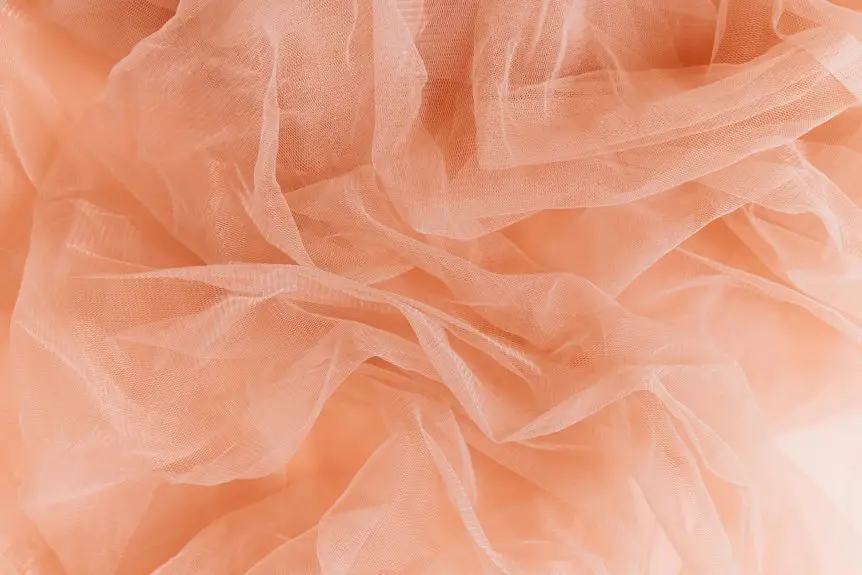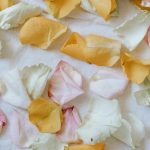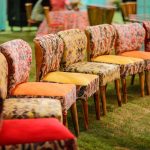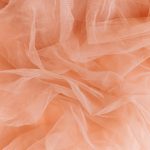If you want a fabric lighter and more breathable than gauze, consider cotton lawn or voile—they’re finely woven yet airy, keeping you cool. Linen is another great choice, offering natural breathability and moisture-wicking. Silk chiffon provides elegance with lightness, while bamboo fabric is soft, breathable, and gentle on sensitive skin. Muslin offers a tighter weave with smoothness, but gauze remains the airiest. To pick the perfect fabric for your needs, explore how weave and fiber impact comfort.
Table of Contents
Key Takeaways
- Cotton lawn offers a lighter, tightly woven alternative with smooth texture and excellent breathability for warm-weather clothing.
- Linen provides superior breathability and moisture-wicking, keeping wearers cool and dry with natural durability.
- Bamboo fabric combines lightweight softness with hypoallergenic and moisture-wicking properties, ideal for sensitive skin.
- Silk chiffon is lightweight and airy with natural wrinkle resistance, adding elegance without sacrificing breathability.
- Voile fabric is semi-sheer and breathable, slightly less airy than gauze but offers better wrinkle resistance and smooth drape.
Characteristics of Gauze Fabric
Gauze fabric stands out for its lightweight, open-weave structure that makes it highly breathable and soft to the touch. When you handle gauze, you’ll notice how airy and flexible it feels, allowing air to circulate freely. This quality makes it ideal for warm weather or layering without adding bulk.
You’ll also appreciate its slightly crinkled texture, which gives gauze a casual, relaxed look. Despite its delicate appearance, gauze is surprisingly durable, especially when crafted from cotton or blends.
However, it tends to wrinkle easily and may require gentle care to maintain its softness. If you want a fabric that balances comfort, breathability, and a unique texture, gauze fabric is a smart choice to contemplate for your projects.
Cotton Lawn: A Lightweight Alternative
If you’re drawn to lightweight, breathable fabrics but want something with a smoother finish, cotton lawn offers a great alternative.
This fabric is made from fine, tightly woven cotton fibers, giving it a crisp texture that feels soft against your skin. Unlike gauze, which is more textured and loosely woven, cotton lawn provides a sleek surface that drapes beautifully without sacrificing airflow.
Fine, tightly woven cotton fibers create a crisp yet soft texture that drapes beautifully and breathes well.
You’ll find it ideal for warm-weather clothing like blouses, dresses, and shirts because it lets air circulate while maintaining a polished look.
Plus, cotton lawn is durable and easy to care for, so you won’t have to worry about frequent replacements.
When you want lightness and breathability with a refined touch, cotton lawn fits the bill perfectly.
Voile Fabric and Its Breathability
You’ll notice voile fabric is lightweight and semi-sheer, making it a popular choice for warm weather.
It’s more tightly woven than gauze, so it offers good breathability while still providing a bit more structure.
Let’s explore how voile compares to gauze when it comes to staying cool and comfortable.
Voile Fabric Characteristics
Voile fabric offers a lightweight and semi-sheer texture that makes it perfect for warm weather clothing. You’ll notice it’s tightly woven from cotton or cotton blends, giving it a smooth, soft feel against your skin. This fabric drapes well and resists wrinkles, making it ideal for dresses, blouses, and curtains. Unlike gauze, voile has a finer weave, which balances breathability with a touch more structure. It’s also easy to dye, so it comes in vibrant colors and prints.
| Characteristic | Description | Benefit |
|---|---|---|
| Fiber Content | Cotton or blends | Softness and durability |
| Weave Type | Plain weave, fine yarns | Lightweight, smooth drape |
| Opacity Level | Semi-sheer | Elegant, airy appearance |
Breathability Compared to Gauze
While voile provides a smooth, semi-sheer look with a bit of structure, gauze stands out for its exceptional breathability.
When you wear gauze, air flows freely through its loose weave, keeping you cooler in hot weather. Voile, though lightweight and breathable, has a tighter weave that slightly limits airflow compared to gauze.
If your priority is maximum ventilation for activities like summer outings or layering in humid climates, gauze is the better choice. However, voile offers a balance of breathability with a refined appearance, making it ideal when you want something airy but a bit more polished.
Ultimately, gauze wins in pure breathability, but voile serves you well if you need lightness combined with subtle structure.
Exploring Linen for Warm Weather
When you choose linen for warm weather, you benefit from its natural fiber that’s strong yet lightweight.
Its breathability often surpasses gauze, keeping you cooler on hot days.
You’ll find linen perfect for everything from casual shirts to summer dresses.
Linen Fiber Characteristics
Linen stands out for its breathability and moisture-wicking properties, making it an ideal choice for warm weather. When you choose linen, you get a fabric made from flax fibers, which are naturally strong and durable. These fibers have a smooth surface that allows air to flow freely and moisture to evaporate quickly, keeping you cool and comfortable. Linen’s texture can feel slightly crisp at first but softens with each wash. Plus, it resists pilling and retains its shape well.
| Characteristic | Description | Benefit |
|---|---|---|
| Fiber Source | Flax plant fibers | Natural and sustainable |
| Strength | High tensile strength | Long-lasting fabric |
| Moisture Absorption | Up to 20% without feeling damp | Keeps you dry |
| Texture | Crisp but softens over time | Comfortable wear |
Breathability Compared to Gauze
Because gauze and linen both excel in breathability, comparing the two helps you decide which fabric suits warm weather best.
Gauze’s loose weave allows air to flow freely, making it exceptionally lightweight and airy. However, linen’s breathability comes from its natural fiber structure and slightly tighter weave, which still promotes excellent airflow while offering more durability.
When you wear linen, moisture wicks away quickly, keeping you dry and comfortable in heat.
Gauze feels softer and more delicate but can be less durable and prone to wrinkles. Linen, on the other hand, breathes well without sacrificing strength or structure.
Ideal Uses in Warm Weather
If you’re aiming to stay comfortable during hot days, choosing the right fabric plays a big role.
Linen is an excellent choice for warm weather because it’s lightweight and highly breathable. It absorbs moisture quickly, helping you stay dry and cool even when the temperature rises.
You’ll find linen ideal for casual wear like shirts, dresses, and shorts, as well as for bed linens and curtains that promote airflow.
Unlike gauze, linen holds its shape better while still allowing air to circulate freely.
Just keep in mind that linen wrinkles easily, so if you prefer a crisp look, you might need to iron it more often.
The Advantages of Silk Chiffon
When you choose silk chiffon, you get a fabric that combines elegance with lightweight comfort. This sheer material feels incredibly soft against your skin, making it perfect for warm weather.
Its fine weave allows air to flow freely, so you stay cool without sacrificing style. Silk chiffon also drapes beautifully, giving your outfits a graceful, flowing look that’s hard to match.
Plus, it naturally resists wrinkles and has a subtle sheen, adding a touch of luxury to whatever you wear. While delicate, this fabric’s breathability and lightness make it ideal for dresses, scarves, and blouses when you want something both airy and refined.
If you want a breathable alternative to gauze that feels upscale, silk chiffon is a smart choice.
Bamboo Fabric: Soft and Breathable
While silk chiffon offers a luxurious feel and elegant drape, bamboo fabric brings its own set of impressive qualities that make it worth considering.
You’ll find bamboo incredibly soft, often compared to cashmere or silk, making it gentle on your skin. It’s naturally breathable and moisture-wicking, so you stay cool and dry even in warm weather.
Bamboo fabric also resists odors and has antibacterial properties, which is perfect if you want clothes that stay fresh longer. Plus, it’s eco-friendly, as bamboo grows quickly without pesticides.
If you’re looking for a lightweight, breathable alternative that feels smooth and cool, bamboo fabric is a smart choice. It balances comfort and sustainability, giving you a fresh option beyond traditional fabrics.
Comparing Muslin to Gauze
Muslin and gauze are both lightweight, breathable fabrics often used for similar purposes, but they’ve distinct textures and uses you should know about.
Muslin features a tighter weave, giving it a smoother feel and a bit more durability than gauze. You’ll find muslin ideal for clothing, curtains, and swaddling blankets where softness and strength matter.
Muslin’s tighter weave offers smoothness and durability, perfect for soft, strong clothing and home textiles.
Gauze, on the other hand, has a looser weave, making it airier and lighter. This makes gauze perfect for medical dressings, lightweight scarves, or summer wraps where maximum airflow is essential.
If you want a fabric that balances breathability with a bit more structure, muslin’s your go-to. But if you prioritize ultimate lightness and breathability, gauze stands out.
Choosing between them depends on how you’ll use the fabric.
The Role of Fabric Weave in Breathability
How does the weave of a fabric influence its breathability? The weave determines how air flows through the fabric. Looser weaves create larger gaps, allowing more air to pass, keeping you cooler. Tighter weaves trap heat and moisture, reducing breathability. When choosing fabrics, consider the weave type to match your comfort needs.
| Weave Type | Breathability Level |
|---|---|
| Plain Weave | High – open structure allows airflow |
| Twill Weave | Moderate – diagonal pattern slightly denser |
| Satin Weave | Low – smooth, tightly packed fibers restrict air |
Understanding these differences helps you pick fabrics that keep you comfortable, especially in warm weather.
Choosing the Right Fabric for Sensitive Skin
If you have sensitive skin, choosing the right fabric can make a big difference in comfort and irritation. You want materials that are soft, breathable, and hypoallergenic to avoid redness and itching.
Natural fibers often work best because they allow your skin to breathe and reduce moisture buildup.
Consider these fabrics:
- Cotton: Soft, breathable, and widely available; good for everyday wear.
- Bamboo: Naturally hypoallergenic and moisture-wicking, gentle on skin.
- Silk: Smooth texture reduces friction and irritation.
- Linen: Lightweight and breathable, perfect for hot weather.
Avoid synthetic fabrics that trap heat and cause sweating, which can aggravate sensitive skin.
Choosing the right fabric helps you stay comfortable and reduces the risk of skin flare-ups.
Frequently Asked Questions
How Do Fabric Care Requirements Differ Among These Lightweight Materials?
You’ll find care varies: some lightweight fabrics need gentle washing and air drying to keep shape, while others tolerate machine cycles. Always check labels, avoid high heat, and handle delicate fibers with extra care to maintain breathability.
Which Fabrics Are Most Durable for Everyday Wear?
You’ll find cotton canvas and denim highly durable for everyday wear, resisting wear and tear well. Synthetic blends like polyester also hold up, especially when mixed with natural fibers. Choose fabrics that balance comfort and toughness.
Are Any of These Fabrics Hypoallergenic for Sensitive Skin?
You’ll find that natural fabrics like organic cotton and bamboo are usually hypoallergenic, making them great for sensitive skin. They breathe well and minimize irritation, so you can wear them comfortably without worrying about allergic reactions.
How Do These Fabrics Perform in Moisture-Wicking?
Imagine sweat evaporating instantly as you move—these fabrics wick moisture away, keeping you dry and comfortable. You’ll find cotton gently absorbs, while linen and bamboo pull moisture faster, letting your skin breathe freely during any activity.
What Are the Environmental Impacts of Producing These Fabrics?
You’ll find natural fibers like cotton use more water, while synthetics rely on fossil fuels, causing pollution. Choosing organic or recycled fabrics reduces environmental harm, so you should consider production methods to lessen your impact.
- Does Polycotton Fray? Tips for Sewing and Finishing Edges - June 23, 2025
- Can Polycotton Be Washed at 60 Degrees? A Safe Washing Guide - June 23, 2025
- Can Polycotton Be Used for a Face Mask? Safety and Breathability Facts - June 23, 2025






